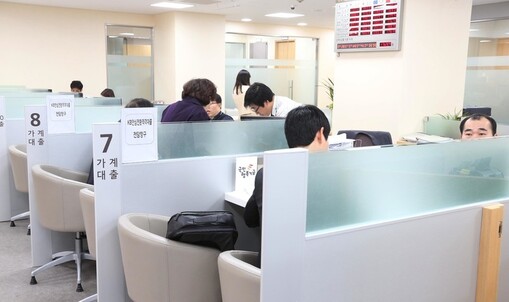
Hankyoreh material photo. Reporter Lee Jung-woo
Although domestic banking performance improved last year due to the increase in household and corporate loans, net income declined due to large-scale provision for bad debts in preparation for the uncertainty of Corona 19. Looking at the “2020 domestic banks’ provisional results for 2020,” announced by the Financial Supervisory Service on the 8th, last year’s provisional net income for domestic banks was 12.3 trillion won, a decrease of 1.6 trillion won (11.5%) from 13 trillion won in 2019. The operating income itself has increased. First of all, interest income, a major source of income for banks, increased by 500 billion won (1.2%) from the previous year to 41.2 trillion won. As the base interest rate fell, the net interest margin (NIM), which was minus the cost of financing from the deposit margin (the difference between the deposit rate and the loan rate), fell 0.15% points from the previous year to 1.41%. This is because it was 2521 trillion won, an increase of 22.2 trillion won (9.7%) from the previous year. Non-interest income also increased by KRW 800 billion (11.7%) from the previous year to KRW 7.3 trillion. As the won-dollar exchange rate declined from the previous year, gains related to foreign exchange and derivatives increased, and the interest rate of government bonds fell from the previous year (increased government bond prices), leading to an increase in securities-related profits of banks. Non-operating losses also decreased from KRW 1.1 trillion to KRW 900 billion, showing a clear improvement in profits. However, each bank’s bad debt expenses (the amount of loan loss provisions minus the reversal amount) amounted to KRW 3 trillion (88.7%) compared to the previous year, resulting in a decrease in net income for the period. This is because last year, banks have newly accumulated large-scale loan loss provisions in preparation for the Corona 19 economic shock. Provision for bad debt is an accounting method that reflects the loss cost of a receivable that is expected to lose. Some of the loan assets are stored in preparation for the risk of insolvent, and if the money is returned in the future, it is converted into non-operating income. Sales and management expenses of domestic banks were also KRW 500 billion (1.9%) compared to the previous year, which was KRW 24.11 trillion, which affected the decrease in net income. By Shin Da-eun, staff reporter [email protected]
